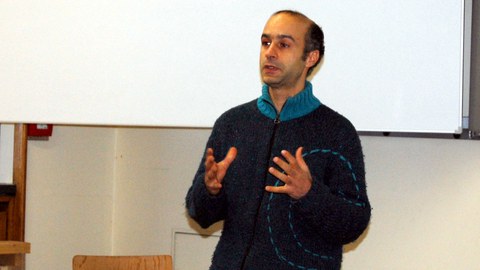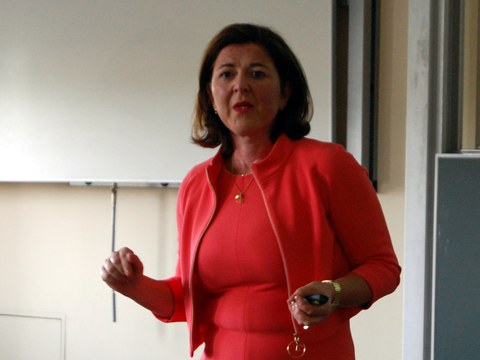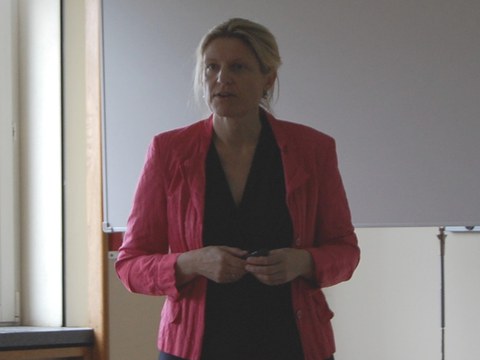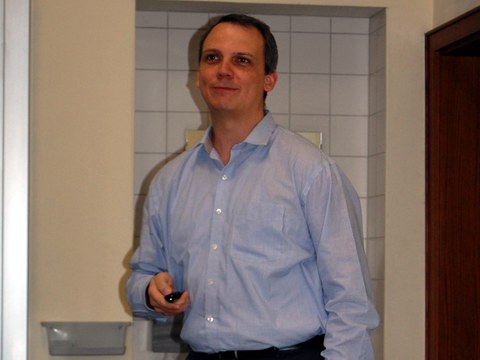Historie 2016
Das ZIH-Kolloquium ist eine öffentliche Veranstaltung. Es findet regelmäßig am 4. Donnerstag eines Monats um 15:00 Uhr im Willers-Bau A317 statt.
Bei zusätzlichen oder außerplanmäßigen Veranstaltungen sind Zeit und Örtlichkeit explizit angegeben.
Vergangene Termine
24. November 2016: Nazim Fates (Inria - Loria, Nancy, France) "Problems of synchronisation in cellular automata: the role of randomness” (Folien)
Imagine a system composed of cells with discrete states which interact locally at discrete time steps. Is it possible to make all the cells blink synchronously? We examine this question in the framework of cellular automata, requiring that every initial condition leads to a homogeneous and blinking cell configuration. The difficulty lies in the fact that each cell has only a partial view of the system and that there is no external synchronising stimulus that can be used. We exhibit two paradoxical results: a) contrary to what has long been expected, the problem cannot be solved exactly for deterministic systems, but it is possible to construct solutions „almost perfect”. b) If some randomness is allowed in the transition rule of the cells, it then becomes difficult NOT to solve the problem! The talk will also survey further aspects of this problem: from the discoveries of C. Huyghens in the 17th century to the questions raised by A. Turing on morphogenesis, we will investigate the „tension” that exists between deterministic and stochastic models, and discuss the constructive role of randomness.
Nazim Fatès is interested in cellular automata and more particularly in understanding the role that random events can play in their behaviour. After a PhD on asynchronous cellular automata (ENS Lyon, 2004), he has worked as a full-time researcher at the Inria Institute in Nancy, France. He has proposed techniques to estimate the convergence properties of various discrete cellular systems and has used these tools to construct efficient solutions to some well-known inverse problems such as the density classification problem. Nazim Fatès is also interested in relationships between biology and computer science.
22. September 2016: Betrix Weber (Leiterin Forschungsgruppe Recht in Nachhaltigkeit, Compliance und IT - Professorin für Gewerblichen Rechtsschutz und IT-Recht, Hochschule Hof): „Recht und Compliance für Forschungsdaten“ (Folien)
Jeder Forscher, der bei seinen Forschungsvorhaben Daten erhebt, speichert, verarbeitet und veröffentlicht, muss sich mit den rechtlichen Möglichkeiten und Grenzen seines Vorgehens beschäftigen. Rechtliche Relevanz haben vor allem personenbezogene Daten, Betriebsgeheimnisse, Daten im Vorfeld einer Patentanmeldung, der Schutz von Know how, der Schutz des Datenbankherstellers beim Aufbau von Datenbanken und die Abgrenzung von Daten und Programmen. Forschungsfreiheit und Anwendungsbezug, inbesondere in Drittmittel geförderten Vorhaben, müssen sich im Rahmen der einschlägigen Gesetze wie BDSG, EU-Datenschutzgrundverordnung, UrhG, UWG und StGB bewegen. Recht, Compliance und Datensicherheit können dann eine gute Grundlage für rechtskonformes und wissenschaftliches Wohlverhalten für die Nutzung von Daten in der Forschung sein.
Frau Prof. Dr. Beatrix Weber, MLE, ist Professorin für Gewerblichen Rechtsschutz und IT-Recht und Leiterin der Stabsstelle Compliance an der Hochschule für Angewandte Wissenschaften Hof sowie der Forschungsgruppe „Recht in Nachhaltigkeit, Compliance und IT“ am Institut für Informationssysteme. Forschungsschwerpunkte sind Rechtsfragen der Digitalisierung, Industrie 4.0, Datenschutz, Law Process Modeling und Compliance.
23. Juni 2016: Stefan Schuster (Friedrich-Schiller-Universität Jena) " Use of Evolutionary Game Theory in Biochemistry and Microbiology"
Systems biology focusses on the interactions of many constituents in living systems, which may bring about emergent properties. One methodology to study emergent properties in biology is by Evolutionary Game Theory. This is here illustrated by two examples from biochemistry and microbiology: (1) Microorganisms are often engineered to produce a variety of extracellular enzymes, for example, for producing renewable fuels and in biodegradation of xenobiotics. Productivity is often reduced by "cheater" mutants, which are deficient in exoenzyme production and benefitting from the product provided by the "cooperating" cells. We present a game-theoretical model to analyze population structure and exoenzyme productivity. Our results indicate that microbial strains engineered for exoenzyme production will not normally be outcompeted by cheater mutants. (2) The polymorphic fungus Candida albicans can cause disease in humans. Host resistance against these infections is mediated by macrophages among others. Two strategies are available for each pathogenic yeast cell when ingested by a macrophage: avoiding lysis transiently or attacking the macrophage from the inside and escaping. In dependence on parameter values, two different outcomes can be derived: when the difference of the costs of the two strategies is low, all fungal cells inside a macrophage will attack, while in the high-cost case, a mixed population of attacking and “silent” cells is the only stable solution. Our results are in agreement with wet-lab results presented by other groups and the model parameters can be estimated from experimental data. Finally, I will discuss to what extent macromolecules can be considered as players.
Stefan Schuster is the head of the Chair of Bioinformatics at the Faculty of Biology and Pharmacy, Friedrich Schiller University Jena. In addition, he is one of the two speakers of the Jena Centre for Bioinformatics. After his graduation in biophysics at the Humboldt University he worked in the Netherlands, France, Slovenia, and the Max Delbrück Center for Molecular Medicine Berlin-Buch. His research interests include systems biology, metabolic pathway analysis, and Evolutionary game theory.
26. Mai 2016: Frauke Lohr (comsciencia) "Einsatz von Text Mining in der Beratungspraxis"
Angesichts einer zunehmenden Datenflut bietet Text Mining einen innovativen Ansatz zur Beantwortung unterschiedlicher Fragestellung aus der Praxis von Wirtschaft, Wissenschaft und Politik. Text Mining bietet dabei die Möglichkeit einer ganzheitlichen Perspektive durch systematische Analyse und Verknüpfung von Informationen auf der Basis großer unstrukturierter Datenmengen, wo traditionelle Recherchetechniken an ihre Grenzen stoßen. Dadurch können verschiedenste Fragestellungen aus der Praxis auf neue Art und Weise aussagekräftig und umfangreich mit praktischem Nutzen bearbeitet werden.
Die Methode wurde ausgehend von der Wissenschaft entwickelt und findet immer mehr Anwendungen im praktischen Bereich, die im Vortrag dargestellt werden.
Einführend werden das generelle Vorgehen und die Vorteile gegenüber bisherigen Bearbeitungsmethoden dargestellt. Das Spektrum möglicher Fragestellungen von praktischer Relevanz wird skizziert und nachfolgend anhand verschiedener Anwendungsbereiche aus der Chemie, der Medizin sowie dem Umgang mit gesellschaftlichen Herausforderungen exemplarisch beleuchtet.
Dr. Frauke Lohr ist seit Ende 2011 freiberuflich unter dem Markennamen comsciencia als Beraterin und Business Coach für Transformationsprozesse tätig. Sie ist promovierte Chemikerin und besitzt langjährige Erfahrung in der Beratung von Wirtschaft, Wissenschaft und Politik sowie den zugehörigen Schnittstellen.
Ihre Expertise liegt in der Verknüpfung von Strategie- und Organisationsentwicklung, speziell im Innovationsumfeld. Ihre breite Wissensbasis speist sich aus eigenen Erfahrungen der akademischen Laufbahn sowie 13-jähriger Tätigkeit in verschiedenen Managementpositionen bei Evonik Industries AG, ehemals Degussa. Im Anschluss daran war sie ab 2008 mehrere Jahre lang Senior Partnerin und Mitgeschäftsführerin in einem kleineren Beratungsunternehmen.
12. Mai 2015, 14:30, Trefftz-Bau 101 – ZIH Visitor Center: Additional Colloquium with Rainer Klages (Queen Mary University of London, School of Mathematical Sciences) "Anomalous dynamics of cell migration"
Cell movement, for example, during embryogenesis or tumor metastasis, is a complex dynamical process resulting from an intricate interplay of multiple components of the cellular migration machinery. At first sight, the paths of migrating cells resemble those of thermally driven Brownian particles. However, cell migration is an active biological process putting a characterization in terms of normal Brownian motion into question. By analyzing the trajectories of both wild-type and mutated epithelial (transformed Madin-Darby canine kidney) kidney cells, we show experimentally that anomalous dynamics characterizes cell migration. A superdiffusive increase of the mean square displacement, non-Gaussian spatial probability distributions and power-law decays of the velocity autocorrelations are the basis for this interpretation. Almost all results can be explained with a fractional Klein-Kramers equation allowing the quantitative classification of cell migration by a few parameters.
Rainer Klages is an associate professor for Applied Mathematics at the School of Mathematical Sciences of the Queen Mary University of London and currently on academic leave as a guest scientist at the Max Planck Institute for the Physics of Complex Systems, Dresden. He obtained his Ph.D. in physics at the TU Berlin and his habilitation in theoretical physics at the TU Dresden. His research interests are in nonequilibrium statistical physics, dynamical systems, stochastic processes, movement ecology, biophysical modelling, nanosystems and, computer simulations.
10. März 2016: Martin Schulz (Lawrence Livermore National Laboratory, Livermore, USA) "Performance Analysis for the Exascale Era: From Measurements to Insights" (Folien)
With rising system and application complexity, performance analysis is more important, but also more difficult than ever. Traditional performance are capable of measuring large volumes of performance data that can help with this process, but the interpretation of this data is becoming the more and more the bottleneck.
Simply comparing individual performance metrics, such as Flop/s and cache misses, and relate them to source code, is no longer sufficient. Instead we require novel approaches that allow a deeper correlation of performance data with application and communication structures, that take the system environment into account, that provide multiple views on measured data, and that offer intuitive visualizations to enable actionable insight.
In this talk I will discuss a general methodology that enables such kind of tools, discuss infrastructure elements that enable software stack wide instrumentation, and I will present two novel performance visualization tools as case studies: MemAxis, a memory analysis tool to gather and display data movement within NUMA systems, and Ravel, a trace visualizer based on logical time. Both tools provide the developer with an application centric view of performance data, which aids in capturing the performance behavior of the application and thereby enables optimization.
Dr. Martin Schulz is a Computer Scientist at the Center for Applied Scientific Computing (CASC) at Lawrence Livermore National Laboratory (LLNL). He is the PI of several DOE exascale related efforts, including the performance analysis project PIPER, as well as the current chair of the MPI forum. His research focus is on parallel development tools and systems, power-aware HPC and resilience, all with an emphasis on scalability.
28. Januar 2016: Michael Bussmann (HZDR Rossendorf) "Alpaka, GrayBat and other spiritual animals that will help you survive in the dangerous world of HPC"
Implementing codes for simulations or large-scale, high rate data analysis on modern compute hardware can take much of the time that you initially wanted to spend on something entirely else. We present our tool box of simple yet powerful solutions for writing hardware-independent, scalable and performant codes that are maintanable and can survive the next compute hardware update. We show that with modern programming techniques it is possible to implement abstract interfaces that provide sustainable concepts for parallel programming while at the same time allowing for performance optimization. This talk is about real life applications that need to work. But it will also be cool.
Following an unsuccessful search for the Higgs Boson at CERN Michael Bussmann received his PhD in experimental physics at LMU München in the field of laser cooled ion beams in storage rings. Since 2010 he is heading the group Computational Radiation Physics at the Helmholtz-Zentrum Dresden-Rossendorf, where he develops HPC simulations and is responsible for highly parallel image processing strategies.
Vergangene Jahre
Historie 2014/2015
Historie 2013
Historie 2012
Historie 2011
Historie 2010
Historie 2009
Historie 2008
Historie 1998 - 2007





